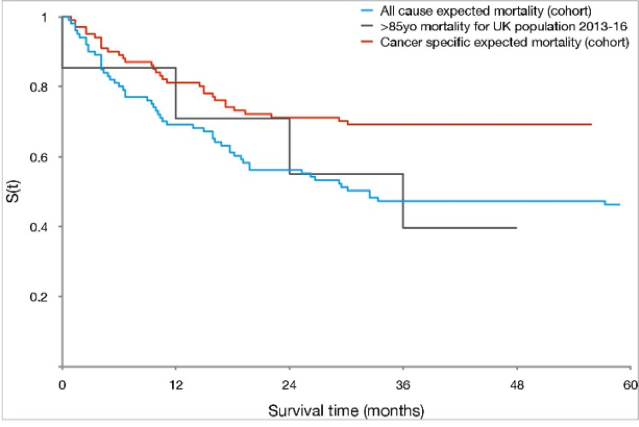In this study, the authors describe their experience treating patients older than 85 with bladder cancer. This was a retrospective review of patients aged over 85 years, first diagnosed with bladder cancer between 2013 and 2016 in a single institution in the UK.
A total of 102 patients were identified and analyzed. Mean age at diagnosis was 88.3 years. The staging at diagnosis was: 75% had non-muscle invasive bladder cancer (NMIBC) (17 low risks, 13 intermediate, 45 high risks), 23% had muscle-invasive bladder cancer (MIBC), (4 with the synchronous metastatic disease).
Of the 75 patients with NMIBC, 29 (38.7%) experienced a recurrence, 4 (5.3%) were upstaged from low to high risk, and 9 (12%) progressed from NMIBC to MIBC. When assessing the treatment choices made by these patients, it is interesting to find that 38.7% (29/75) of NMIBC patients declined any kind of treatment or surveillance protocol during the follow-up period.
A total of 38.7% of NMIBC patients developed a recurrence during the study period, with a median time to recurrence of 293 days. The recurrence data stratified by initial risk category is shown in Table 1.

Table 1 – Recurrence data stratified by initial risk category:
Overall, 53% (53/102) had died during the following- up period from any cause, at a mean interval of two years from diagnosis. Out of the NMIBC patients, 40% (30/75) of the patients died of any cause since diagnosis (mean time from diagnosis of 1.8y). Lastly, a total of 28 patients (37.3%) died due to their bladder cancer. Figure 1 demonstrates the Kaplan-Meier curves of cancer-specific, and overall survival of these patients, together with the national mortality rates of the UK population older than 85 during the study period.

Figure 1 – Kaplan Meier curve of cancer-specific, and overall survival:
This cohort of patients older than 85 years old, demonstrated a high overall mortality rate within a relatively short period following diagnosis. These data should be presented to patients older than 85 when deciding on which treatment options to pursue. The limitations of this study include its relatively small sample size, retrospective nature, short follow-up time, and the fact that these data only represent a single institution. Furthermore, no data is given on how muscle-invasive bladder cancer patients were treated, how many underwent radical cystectomy, and how did they fair. The debate on how to treat elderly patients with NMIBC or muscle-invasive bladder cancer is still not resolved, and more long-term prospective studies are required to truly ascertain how to properly treat these patients. The treatment of these patients should be tailored in such a way that prolongs their life expectancy, but at the same time refrains from altering their quality of life.
Presented by: Hill George, Bristol Urological Institute, Southmead Hospital, Bristol, UK